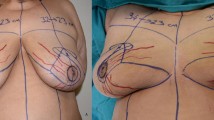Abstract
Background
Necrosis of the nipple–areolar complex (NAC) is one of the most devastating complications of reduction mammoplasty. A variable, asymmetrical pattern of blood supply from the main sources was found in the same individual. To solve this problem, we present a method to be sure that the blood supply to the NAC is contained within the designed pedicle during reduction mammoplasty. This is done using the colored duplex scan and handheld Doppler to perform freestyle perforator flap reduction mammoplasty.
Methods
This is a prospective randomized study that has been performed on 105 patients in the period between January 2014 and 2019 at the Plastic and Reconstructive Surgery Department, Tanta University Hospitals. Freestyle perforator flaps were performed for all cases after perforator detection using handheld Doppler and confirmed by colored duplex scan.
Results
The procedure was performed as freestyle on medial perforators in 35 (33.3%) cases, on lateral perforators in 20 (19%) cases, on combined medial and lateral perforators, as a bipedicle in 30 (28.7%) cases, on upper pole perforators in 12 (11.4%) cases, and on lower pole perforators in 8 (7.6%) cases.
Conclusions
The use of handheld Doppler and the confirmation by duplex scan are mandatory to decrease the incidence of NAC necrosis or ischemia.
Level of Evidence IV
This journal requires that authors assign a level of evidence to each article. For a full description of these Evidence-Based Medicine Ratings, please refer to Table of Contents or online Instructions to Authors www.springer.com/00266.







Similar content being viewed by others
References
Stranz G, Petri E (1999) Different techniques of reduction mammaplasty comparing clinical and esthetic complications with patient satisfaction. Zentralbl Gynakol 121(9):434–440
van Deventer PV, Page BJ, Graewe FR (2008) The safety of pedicles in breast reduction and mastopexy procedures. Aesthetic Plast Surg 32:307–312
Agbenorku P, Agamah G, Agbenorku M, Obeng M (2012) Reduction mammaplasty in a developing country: a guideline for plastic surgeons for patient selection. Aesthetic Plast Surg 36(1):91–96
Hammond DC, Loffredo M (2012) Breast reduction. Plast Reconstr Surg 129(5):829e–839e
Hollyman JA, Lacey JH, Whitfield PJ et al (1986) Surgery for the psyche: a longitudinal study of women undergoing reduction mammoplasty. Br J Plast Surg 39(2):222–224
Collins ED, Kerrigan CL, Kim M et al (2002) The effectiveness of surgical and nonsurgical interventions in relieving the symptoms of macromastia. Plast Reconstr Surg J 109(5):1556–1566
Viana GA, Pitanguy I, Torres E (2005) Histopathological findings in surgical specimens obtained from reduction mammaplasties. Breast J 14(3):242–248
Titley OG, Armstrong AP, Christie JL et al (1996) Pathological findings in breast reduction surgery. Br J Plast Surg 49(7):447–451
McCulley SJ, Hudson DA (2001) Short-scar breast reduction: why all the fuss? Plast Reconstr Surg J 107(4):965–969
Marchac D (1982) Reduction mammaplasty and correction of ptosis with a short inframammary scar. Plast Reconstr Surg J 69(1):45–55
Chiari A Jr (2001) The L short-scar mammaplasty 12 years later. Plast Reconstr Surg J 108(2):489–495
Hall-Findlay EJ (2016) Discussion: the blood supply of the breast revisited. Plast Reconstr Surg 137(5):1398–1400
Horta R, Silva P, Filipe R, Costa J, Bartosh I, Amarante J, Silva A (2010) Use of Doppler in breast reduction with superomedial or superolateral pedicles. Aesthetic Plast Surg 34(5):680–681
Seitz IA, Nixon AT, Friedewald SM, Rimler JC, Schechter LS (2015) “NACsomes”: a new classification system of the blood supply to the nipple areola complex (NAC) based on diagnostic breast MRI exams. J Plast Reconstr Aesthet Surg 68(6):792
Elmelegy NG, Sadaka MS, Hegazy AM, Abdeldaim DE (2018) Treatment of gigantomastia using a medial–lateral bipedicle reduction mammoplasty: the role of Doppler-assisted preoperative perforator identification. Aesthet Plast Surg 42:73–79
Brown RH, Siy R, Khan K, Izaddoost S (2015) The superomedial pedicle wise-pattern breast reduction: reproducible, reliable, and resilient. Semin Plast Surg 29(2):94–101
Corduff N, Rozen WM, Taylor GI (2010) The superficial venous drainage of the breast: a clinical study and implications for breast reduction surgery. J Plast Reconstr Aesthet Surg 63(5):809–813
Freeman M, Carney M, Matatov T, Vemula R, Babycos C (2015) Leech (Hirudo medicinalis) therapy for the treatment of nipple-areolar complex congestion following breast reduction. Eplasty 15:ic45
Wuringer E, Mader N, Posch E et al (1998) Nerve and vessel supplying ligamentous suspension of the mammary gland. Plast Reconstr Surg J 101(6):1486–1493
O’Dey D, Prescher A, Pallua N (2007) Vascular reliability of nipple-areola complex-bearing pedicles: an anatomical microdissection study. Plast Reconstr Surg J 119(4):1167–1177
Setala L, Papp A, Joukainen S et al (2009) Obesity and complications in breast reduction surgery: are restrictions justified? J Plast Reconstr Aesthet Surg 62(2):195–199
Roehl K, Craig ES, Gomez V et al (2008) Breast reduction: safe in the morbidly obese? Plast Reconstr Surg J 122(2):370–378
Funding
None.
Author information
Authors and Affiliations
Corresponding author
Ethics declarations
Conflict of interest
The authors have no conflict of interest to disclose.
Ethical Approval
All the procedures performed in this study that involved human participants were in accordance with the institutional and national research committee and with the 1964 Helsinki declaration and its later amendments or ethical standards. Accepted principles of ethical and professional conduct have been followed. This article was approved by Tanta University’s Ethical Committee (2013/12/21).
Informed Consent
Informed consent was obtained from all individual participants included in the study, and additional informed consent was obtained from all individual participants for whom identifying information is included in this article.
Additional information
Publisher's Note
Springer Nature remains neutral with regard to jurisdictional claims in published maps and institutional affiliations.
Electronic supplementary material
Below is the link to the electronic supplementary material.
Rights and permissions
About this article
Cite this article
Elmelegy, N., Shokr, T. & Osama, M. Nipple–Areola Complex Ischemia or Necrosis in Freestyle Perforator Flap Reduction Mammoplasty Operations. Aesth Plast Surg 43, 1506–1514 (2019). https://doi.org/10.1007/s00266-019-01511-5
Received:
Accepted:
Published:
Issue Date:
DOI: https://doi.org/10.1007/s00266-019-01511-5




